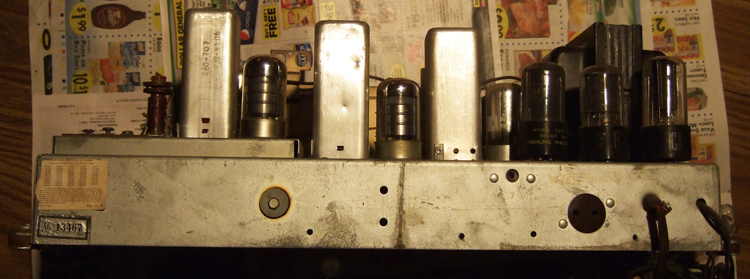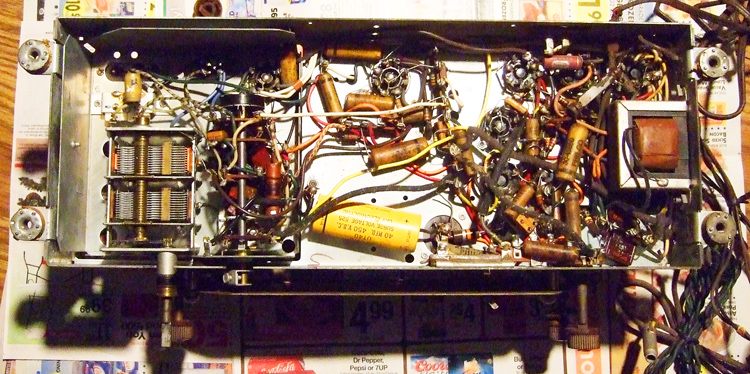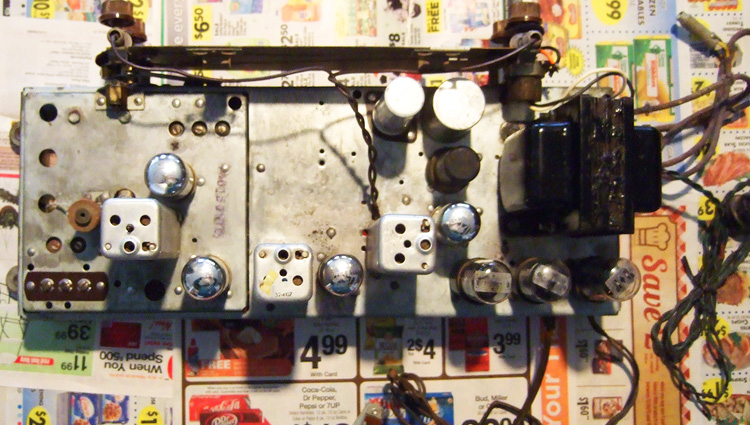Restoring a 46-1226 Code 125
Posts: 348
Threads: 48
Joined: Oct 2013
City: Tioga, Texas, USA
I have a Philco 46-1226 Code 125 to restore. I began by checking the AC input circuit. The bandswitch has to be in the Am or SW position to get the volume control On-Off switch to close and show continuity. On this particular radio, the switch on the volume control seems to be somewhat flaky. It does not show continuity every time it is turned on. It may help to take the switch off of the control and clean it out. I have seen some of these older switches that have lubrication inside that dries out and makes them act up. This particular unit may be a late production version of the Code 125 as it does not have the typical Philco bathtub housing that contains the two .01 AC input filter capacitors. It appears to have a single capacitor bridged across the AC input instead simply attached to a conventional bakelite terminal strip. This will actually be easier to upgrade to a modern AC input safety capacitor.
With continuity of the AC Input established, I went on to check the power transformer secondary and it shows continuity across the AC HV winding and continuity to chassis ground through its center tap, so it appears to be OK. I wanted to establish that much before diving into the rest of the unit. 
The tuning shaft was frozen and would not move. I managed to get it freed up by applying penetrating oil repeatedly and now it does run end to end across the dial.
This is a unit which has Code 125 imprinted on its model number label in the cabinet and it is also samped in ink on the back of the radio chassis. Thanks to some other threads here on this Code 125 version I have enough information to do the restoration. I pulled the chassis out of the cabinet to find the values and voltage ratings of the electrolytic capacitors in the power supply. There are two of them. One is a short large diameter can Philco P/N 30-2556 which is a 25uF@450VC and a 10uF@450VDC with its negative circuit grounded to the chassis. The other is a tall slender diameter can Philco P/N 30-2570 which is a 25uF@450VDC and a 10uF@450VDC with its negative circuit not grounded.
In the process of removing the chassis from the cabinet I discovered that one lead going to the PM speaker was broken open. It appears that it may have gotten caught in the levers associated with the opening and closing of the record changer assembly and those levers may have actually cut the wire apart - it was a clean cut. I will have to carefully look at lead dress when reassembling this unit into its cabinet. The grandson who now owns the radio from an estate said that he remembered it quit playing years ago. An open speaker wire would sure do it.
I looked underneath the chassis and there was a 40uF@450VDC electrolytic that had been bridged across one lead of the 30-2570 capacitor to chassis ground. The connection at the positive terminal was so poorly soldered that it came dangerously close to shorting to the electrolytic can negative twist-lug. Then the positive lead of the added capacitor was not clipped off and was also allowed to come very close to the chassis metal. Someone was living dangerously!!  This will all get cleaned up while rebuilding electrolytics.
I have a lot of the capacitors on hand to take care of most of the coupling and bypass capacitors, but will need to order new electrolytics to restuff the existing electrolytic cans. The 300 ohm resistor coming off of the rectifier cathode shows signs of considerable heat from operation in the past. It may still be OK. I do not intend to turn this set on until I have repaired the electrolytics and verified I have the correct negative bias to the output tube grids. I will check the 6K6 output tubes and also check the output transformer plate to plate to see if the transformer primary is OK.
This unit still has its original 78rpm Philco record changer. The owner wants a modern changer as a replacement so he can play 45s and 33rpm LPs. I can get a changer and cartridge that is made to play stereo LPs and wire it for mono operation and still allow playing of 78rpm records with a flip-over needle. The OEM changer is about 14 5/8 inches wide and 13 1/2 inches deep, so if I look carefully I may be able to find one that will fit without too much adaptation needed.
I will try to get some pictures of the chassis ready for my next post on this unit.
Joe
Posts: 348
Threads: 48
Joined: Oct 2013
City: Tioga, Texas, USA
As promised, here are some pictures of the chassis after vacuuming the worst of the dust off and removing a nest of dead spiders in the tuning capacitor area.



I will start cleaning the top of the chassis. Removing the mouse deposits will help with odor reduction and also make the unit less dangerous to work on. Mice are known disease spreaders and I don't care to acquire any of their equal opportunity diseases.
I note that this chassis does not appear to have any of the dreaded rubber insulated wiring. I have had to deal with some of that in other radios from the same period post WWII.
Joe
Posts: 13,776
Threads: 580
Joined: Sep 2005
City: Ferdinand
State, Province, Country: Indiana
Hi Joe
Once Philco began building radios again after WWII, they used wiring with an improved plastic insulation that has held up well over the decades so far. Its only drawback: It is very sensitive to extreme heat. When you have a soldering gun on a joint trying to unsolder something, just watch the insulation start peeling off the wires connected to that joint. 
--
Ron Ramirez
Ferdinand IN
Posts: 16,561
Threads: 573
Joined: Oct 2011
City: Jackson
State, Province, Country: NJ
(10-29-2017, 09:00 PM)Ron Ramirez Wrote: When you have a soldering gun on a joint trying to unsolder something, just watch the insulation start peeling off ....
Gun? Like a 100W gun? 
I have a Weller's 40W pensil, and it's quite sufficient. I even solder braid to the tuning cap's holding screws with it, though I admit a gun would do a better job in this particular case.
And with AA5 type it's like trying to walk a pet elephant in a china shop. 
People who do not drink, do not smoke, do not eat red meat will one day feel really stupid lying there and dying from nothing.
Posts: 13,776
Threads: 580
Joined: Sep 2005
City: Ferdinand
State, Province, Country: Indiana
My warning is valid. No reason to be critical. 
--
Ron Ramirez
Ferdinand IN
Posts: 348
Threads: 48
Joined: Oct 2013
City: Tioga, Texas, USA
Morzh and Ron;
Yes, I have had to deal with the melting insulation for decades of repair/restoration work and I understand the issue. I use a Weller 100W soldering gun for a lot of work. I also have a Weller 240-325 watt gun to use on electrolytic can twist tabs. As long as the length of time the wires and parts are exposed to the heat is kept short, the amount of damage is minimized. I also have an adjustable soldering iron so that I can control the temperature. It is rated at 40W max and serves well for some situations. I have two different hemostats or siezers that I can use to clamp onto the leads of components and wires that are sensitive to heat exposure. Those carry away the heat and minimize the damage. So does solder wick when taking apart components. I have some clear heat shrink tubing that I sometimes slide over wires that I want to re-use and have some damage to the insulation. We all have run into situations where wires to/from items such as band switches and RF compartments are so congested that it is easier to slide some heat shrink tubing over them and retain the original wires rather than tearing down a unit to extreme levels just to replace a wire or other component.
The 40-201 I have had considerable rubber insulated wires in it that had to be replaced. The IF transformers in particular were just in pitiful shape. I try to use the same color of wires when I replace the existing wires, but cannot always do so. Sometimes I just do not have the right color of wire available to use. I have a couple of boxes crammed with old wiring removed from donor chassis over the years that I can sometimes get the right color and type of wire from. It pays to be a pack-rat. 
Joe
Posts: 348
Threads: 48
Joined: Oct 2013
City: Tioga, Texas, USA
Tomorrow it will be windy and cold and begin to rain later in the day. I am planning to spend the time on the Philco chassis cleaning. I can do that inside the house where it is warm and dry. Today was spent on another project of assembling a cabinet. It can continue with clamps in place while glue cures tomorrow.
This Philco is a nice set, not quite as many tubes (8) as the 40-201 (10), but enough where it counts and the number of IF amps is the same in both sets, so overall signal sensitivity is probably close the although the 40-201 does add an RF amp stage where this one is just a mixer/oscillator followed by two IF stages. The 46-1226 does not have push-button tuning but has the record changer that provided an extra option of entertainment for the owner. Even today I sometimes find nothing on the radio worth listening to and bring out my LP albums to listen to.
One thing I need to check tomorrow is the output transformer to see if both halves of the primary are still good.
Joe
(This post was last modified: 11-01-2017, 04:02 PM by Joeztech.)
Posts: 13,776
Threads: 580
Joined: Sep 2005
City: Ferdinand
State, Province, Country: Indiana
Back when I was doing radio repair for people, I had one of these sets cross my bench. Like you, the owner of the set I restored wanted the original 78 rpm changer replaced with something that would play LPs and 45s. I found a working BSR changer (one that actually used a magnetic cartridge!), cut a new mounting board for it, and installed it in the console cabinet. The owner was thrilled with the finished product, as she had no plans to play any 78s, only LPs and 45s - mainly LPs.
I know BSR is a low grade changer, but it seemed appropriate for the Philco, really. Plus, the client didn't want to spend a lot of $$$ for a changer. Since the BSR had a magnetic cartridge, it worked very well with the Philco's circuitry and its phono preamp since its original 78 rpm cartridge was magnetic also. I wired the cartridge (I think it was a Shure, it's been too many years now) to play in mono.
--
Ron Ramirez
Ferdinand IN
Posts: 348
Threads: 48
Joined: Oct 2013
City: Tioga, Texas, USA
 10-31-2017, 06:40 AM
10-31-2017, 06:40 AM
Ron;
That is very interesting. I did not know that these units had magnetic cartridges. I agree that the BSR brand of changer would be a good choice. They tend to be somewhat lighter in weight than a Garrard and work well enough to do the job. I have had a number of Shure cartridges over the years and still like them. Thanks for the suggestion!
Joe
Posts: 13,776
Threads: 580
Joined: Sep 2005
City: Ferdinand
State, Province, Country: Indiana
Yes, Philco called those cartridges their "dynamic" cartridge. They used them in their higher end 1946-47 and 1948 models. As far as I know they are the same as a mono magnetic cartridge, and they require a preamp circuit just like a magnetic cartridge.
Their drawback was the proprietary design for the stylus, which was a press fit. Too many cheapskates tried to press a steel 78 rpm needle into those cartridges, ruining them. Consequently, not many have survived, and of course the correct stylus is now virtually unobtainium.
I felt I was fortunate in finding that particular BSR for my client. I had not seen a BSR that used a magnetic cartridge prior to that.
--
Ron Ramirez
Ferdinand IN
Posts: 348
Threads: 48
Joined: Oct 2013
City: Tioga, Texas, USA
Ron;
Thanks for the information on the stylus for the existing changer. I found one other person with a restoration thread for these who ran into this issue with the stylus loosing the tip. He epoxied a new stylus from another type of cartridge to the existing lever and it worked OK.
Today I did two things. I worked on cleaning the chassis for about 4 1/2 hours and managed to get rid of the mouse pee and poop deposits. There was some corrosion, but fortunately not too bad and most of that came off without too much difficulty. I also checked the audio output transformer and find that it is still good with continuity to both output tube's plate. That is always another concern about these radios which can be a problem to find as an OEM replacement. There are plenty of generic repair replacements, but my experience has been that none of them really sound as good as the OEM transformers.

I have not checked the tubes yet. I am resting after the hours spent on this. My cat is eyeing me and wanting some lap time after his lunch. It is time for both of us to have a nap.
Joe
Posts: 640
Threads: 48
Joined: Mar 2017
City: Gap Mills Wv 24941
glad to see another like mine get restored.
here is my thread
http://philcoradio.com/phorum/showthread.php?tid=16397
I did a few mods and also solved a few "known" problems with this model.
mine is a code125,,Run3 more specifically.
Posts: 348
Threads: 48
Joined: Oct 2013
City: Tioga, Texas, USA
jcassity;
Thanks for your link! Yours is one of the threads I spotted on restoring a 46-1226 Code 125. I will be referring to it frequently as I proceed. It is great to be able to share information here on these nice radios. I think many things were in a considerable state of change after WWII. Supplies of parts were likely short and it takes a while for manufacturing to ramp up again. The shortages resulted in factory production line changes to get products out to dealers and customers. Television was looming in the future and much research was being put into that type of product line. The advent of lower cost televisions caused the public's allocation of entertainment funding to shift considerably as time moved forward.
Joe
Posts: 640
Threads: 48
Joined: Mar 2017
City: Gap Mills Wv 24941
what run number are you?
there was code 125 run 1, 2 and 3 from the info i have.
Posts: 640
Threads: 48
Joined: Mar 2017
City: Gap Mills Wv 24941
i may have a 6J5GT for you if you want to get away from your metal can type so you can see the thing light up.
I have to check but i believe i do.
Users browsing this thread:
|
|
Recent Posts
|
|
Philco 89 Code 123 Osc Coil
|
| Hello,
I thought I would post my findings on my bad oscillator tickler coil. There were 27 turns on the outer coil b...dconant — 12:38 PM |
|
Philco Model 16 wiring question
|
| Thanks Morzh. So it appears I did wire it incorrectly and I have to switch the wires between pins 2 and 4.bobclausen — 09:24 AM |
|
Philco 46-1209 strange behavior
|
| No, it's not a problem, just during certain condition it could show up.
Yes, an internal tube short could do that too.
...morzh — 09:13 AM |
|
HiFi (Chifi) tube amp build - but my own design.
|
| You sound guys are never satisfied. :crazy: :clap:RodB — 09:10 AM |
|
HiFi (Chifi) tube amp build - but my own design.
|
| I got some new ceramic octal tube sockets installed and also tried some different coupling caps.
The results:
The go...TV MAN — 08:42 AM |
|
Philco 46-1209 strange behavior
|
| I pulled the tube out and it's shorted from pin 1 to pin 2. I suppose that's the problem...sq65 — 08:12 AM |
|
1949 Motorola 5A9M
|
| bob
Nice work on battery . If you don't. Have terminals i have a few spares
Samsam — 02:12 AM |
|
1949 Motorola 5A9M
|
| hello mr Fixr,
for sure !!
I have some radios that I need to make some batteries for too.
Sincerely richardradiorich — 12:33 AM |
|
1949 Motorola 5A9M
|
| Dittos, sweet b on the battery. Love the "9 Lives" logo, remembered from my childhood. Other neat ones are t...MrFixr55 — 11:24 PM |
|
Philco 46-1209 strange behavior
|
| Hi Morzh,
Dunno if the AC EMI caps are an issue. I never liked the concept but never had an issue with these causin...MrFixr55 — 11:21 PM |
|
Who's Online
|
| There are currently no members online. |

|
 
|

 This will all get cleaned up while rebuilding electrolytics.
This will all get cleaned up while rebuilding electrolytics. 


![[-] [-]](https://philcoradio.com/phorum/images/bootbb/collapse.png)


